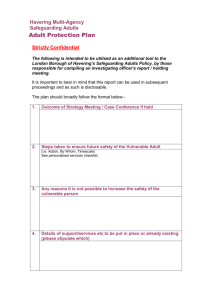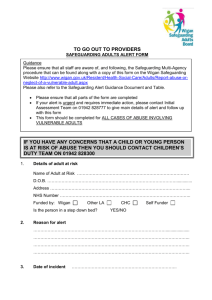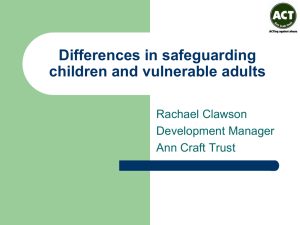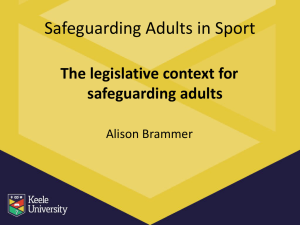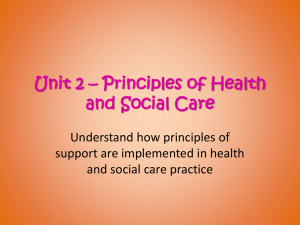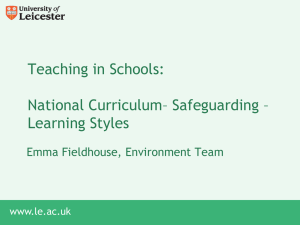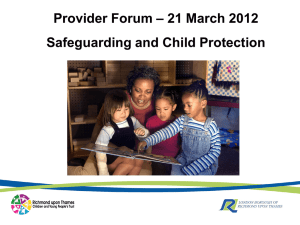presentation
advertisement
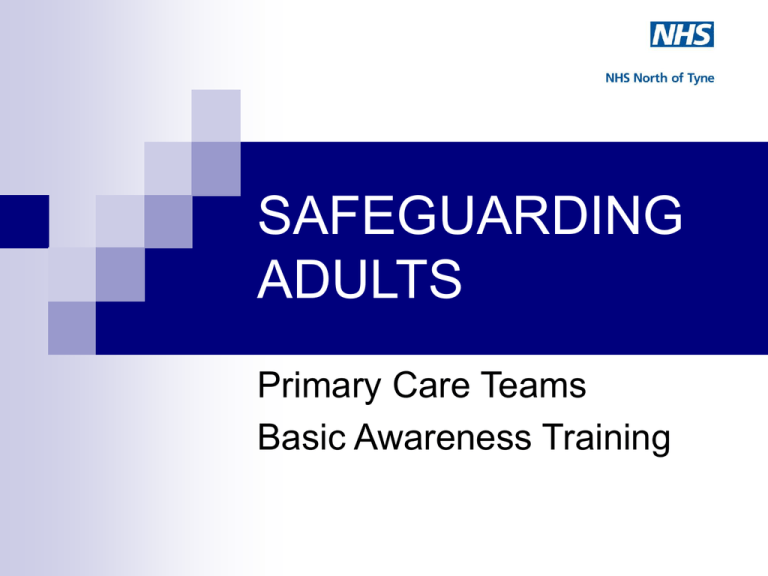
SAFEGUARDING ADULTS Primary Care Teams Basic Awareness Training Safeguarding Vulnerable Adults – BMA Toolkit Health professionals Should be able to identify adults whose physical, psychological or social condition are likely to render them vulnerable Should be able to recognise signs of abuse and neglect, including institutional neglect Need to familiarise themselves with local procedures and protocols for supporting and protecting vulnerable adults Resources for Primary Care Training plan Exemplar policy Checklist Contact details Alerts Scale of the problem In 2010-11 there were 75,000 safeguarding adults referrals which met the threshold for investigation in England The majority of people have a GP Serious case reviews almost always demonstrate GP involvement A tiny number of alerts are made by GP practices Examples Steven Hoskin (Cornwall) Fiona Pilkington Winterbourne View Death by indifference report What do we mean by Safeguarding Adults? ‘ All the work which enables an adult who is or may be eligible for community care services to retain independence, well-being and choice, and to access their human right to live a life that is free from abuse and neglect’ (Safeguarding Adults, ADASS,2005) What do we mean by Vulnerable Adult ? Aged over 18 Who may need care services because of mental health issues, physical or learning disability, age or illness (elderly frail) Who cannot always protect themselves from harm or exploitation Factors Increasing Vulnerability Frail elderly Mental health disorder including dementia and personality disorders Significant physical or sensory impairment Learning disability Severe physical illness Unpaid carer who is under severe stress or is isolated Homeless people Living with someone with a drug or alcohol problem Women as a result of isolating cultural factors Categories of Abuse • • • • • • • Physical Sexual Psychological Financial Neglect Institutional Discriminatory Definition of Abuse • • • • • • • Abuse is a violation of an individual’s human and civil rights by any other person or persons” (No Secrets 2000). It may be intentional or unintentional It may consist of a single act or repeated acts It may cause harm temporarily or over a period of time May occur in any setting People who behave abusively come from all walks of life It may be acts of omissions Factors to Consider 1. 2. 3. 4. 5. 6. 7. One off event or repeated? The impact on victim and others The impact on others e.g. children and families Intent of alleged perpetrator Illegality of alleged actions Risk of repeat to this victim Risk of repeat to other vulnerable adults or children The Jigsaw Doreen Doreen – mother of a man with mental health and alcohol problems Discloses that he has hit her recently What types of abuse are you concerned about? What do you need to know? What might be making her vulnerable? What might protect her? Responding to allegations or concerns Ensure safety Take seriously and remain calm Preserve evidence Avoid leading questions Don’t confront alleged perpetrator Keep records Consider who else might have information Seek advice Examples of Legislation Human Rights Act 1998 Public Interest Disclosure Act 1998 (Whistle Blowing) Data Protection Act 1998 Youth and Criminal Evidence Act 1999 Sexual Offences Act 2003 Protection Of Vulnerable Adults (POVA) 2004 Mental Capacity Act 2005 Safeguarding Vulnerable Groups Act 2006 Health and Social Care Act 2008 Mental Capacity Act Principles Presumption of capacity Maximise decision making ability Freedom to make unwise decisions Best interests Less restrictive alternative Assessing Mental Capacity (MCA1 form) 1. 2. Is there an impairment of, or disturbance in the functioning of the individual’s mind or brain? Complete assessment Understand information Retain information Weigh up information Communicate their decision Decision Making Flowchart Stage 1. Is there a concern that harm has occurred or is likely to occur and is the patient a vulnerable adult? Stage 2. Does the concern relate to significant harm or serious risk of harm? Stage 3. Does the patient consent to safeguarding procedures? Does the patient lack mental capacity for the decision? What is in their best interests? Is there other justified and legal basis to act? How to Refer Local Adult Social Services Phone Follow up with multi-agency alert form Option of discussion and seeking advice After referral Initial information gathering and safeguarding decision (within 24 hours) Strategy meeting or discussion (within 5-7 days) Allocate responsibilities and agree initial protection plan Protection plan meeting (within 28 days) Review meetings and core group meetings Doreen What would you do? What Makes It Difficult to Refer Uncertainty as to what constitutes abuse Uncertainty as to what will happen Concern about impact on relationships Lack of consent Concerns regarding confidentiality Not having the whole picture Record Keeping Document concerns and information in medical records Document information received from other agencies Document discussions and decision making e.g. assessment of capacity Store case conference notes in medical records Prevention Training and awareness Patient information Asking questions Consider in reviews e.g. chronic disease Follow up non attenders e.g. QOF, repeat prescriptions Carers policy Flag records of vulnerable adults Discuss concerns and significant events Contribute to meetings Practice Checklist Safeguarding adults policy Safeguarding adults lead Highlight records of vulnerable adults QOF exception reporting based on clinical decision Patient information available Regular training Significant events discussed Concerns shared within PHCT Carers policy Minimum safety criteria for staff employment Complaints and whistle-blowing policy Guidance “No Secrets” DOH Guidance on implementing Multi-Agency Policy Safeguarding Vulnerable Adults – a toolkit for General Practitioners. British Medical Association Safeguarding Adults. The role of health service practitioners National Competence Framework for Safeguarding Adults Deciding Right (www.theclinicalnetwork.org) Case Studies What type of abuse? What makes them vulnerable? What would you do?
